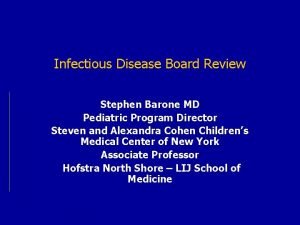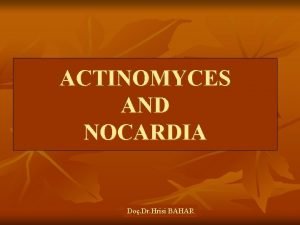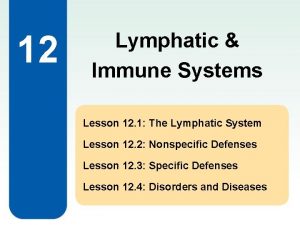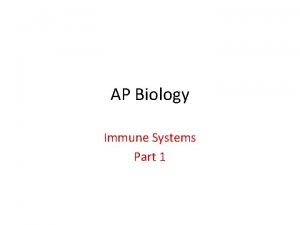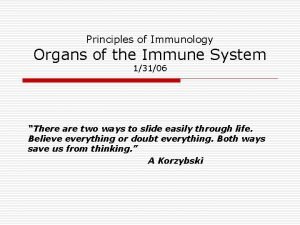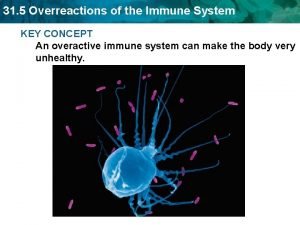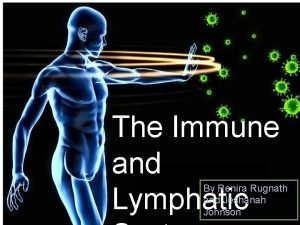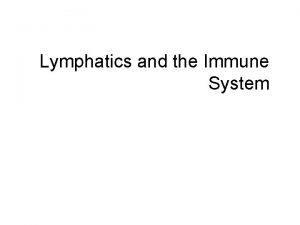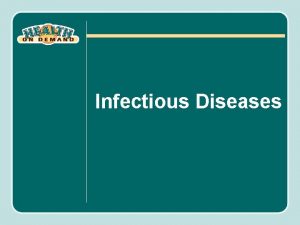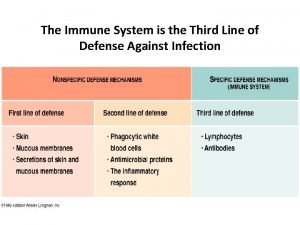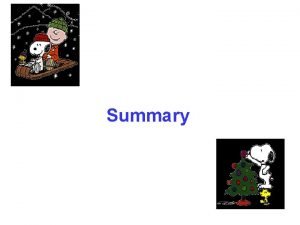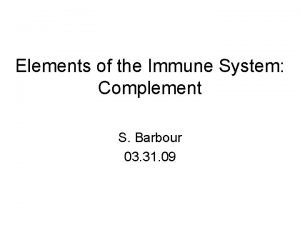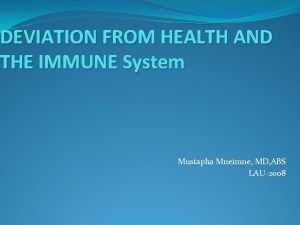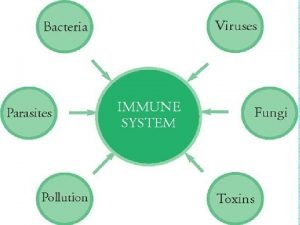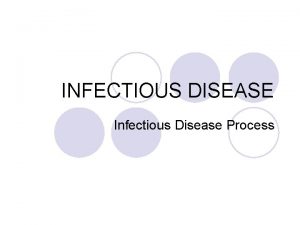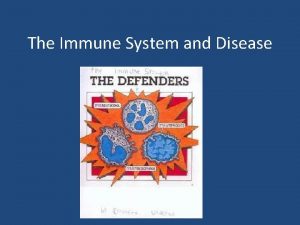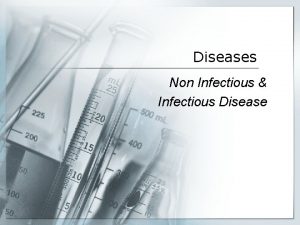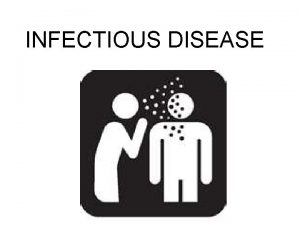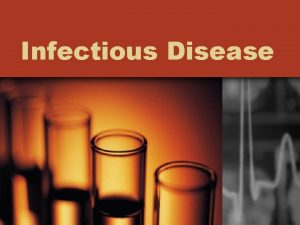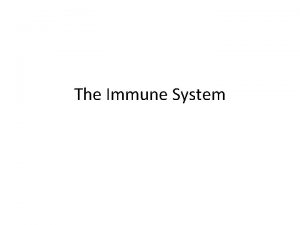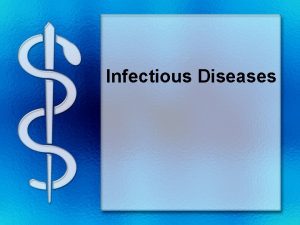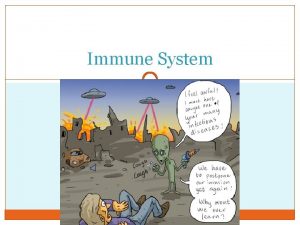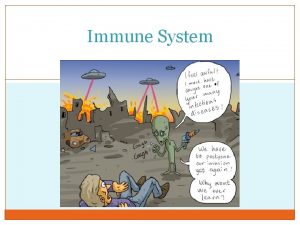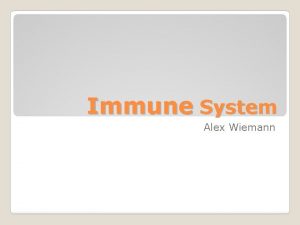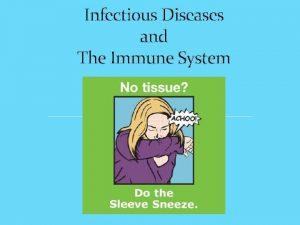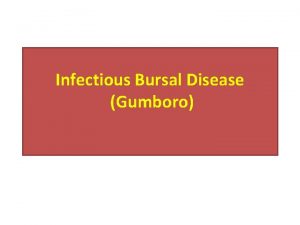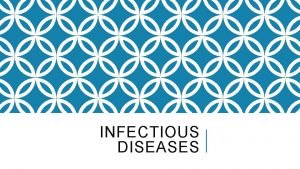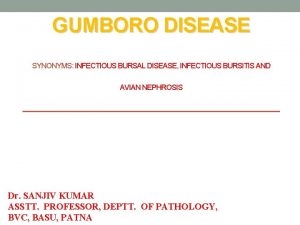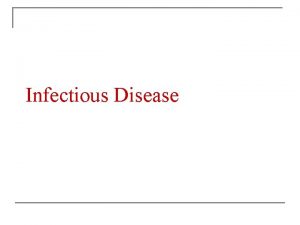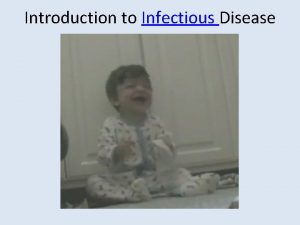Infectious Disease and the Immune System Viruses Viruses




































- Slides: 36

Infectious Disease and the Immune System

Viruses • Viruses are nonliving. • Only characteristic of living organisms is ability to reproduce. • Obligate intracellular parasites.

Viruses • Viruses are composed of; – a nucleic acid- can be dna OR rna. – Protein coat called a capsid which can be different shapes; helical, polyhedral – Some viruses have an envelope of lipids that surround the capsid when they leave a host cell

Viruses • Virus types: – DNA viruses. – RNA viruses.

Viruses • Retroviruses – RNA core. – Must contain an enzyme called reverse transcriptase. – RNA + reverse transcriptase--DNA— inserts into host cell’s DNA—host cells ribsomes make m. RNA —Proteins are part of new viruses

Viroids & Prions • Viroids: – Naked RNA that can replicate. • Prions: – Infectious proteins. – Disrupt the cells activities.

Polio virus Influenza Virus Ebola Rabies

Bacteria • Prokaryotic cells. • Always single cell. • Composed of: – – Cell wall Cell membrane Cytoplasm. DNA that is a single closed loop – NO membrane bound organelles

Plasmids • Some bacteria have a secondary genome called a plasmid. • Small self replicating DNA that cause disease or make the bacteria resistant to antibiotics

Bacteria • Some bacteria have a capsule. – Composed of polysaccharides. – Protects bacteria from WBCs. • Bacteria have short hair like structures called pili for connecting to each other and to hosts.

Nonspecific Defenses

Nonspecific Defenses • Pathogens are disease causing agents. • Resistance is your bodies ability to defend against pathogens. • Your immune system gives you resistance.

Identifying Pathogens Koch’s Postulates • • Pathogen must occur in body of organism with the disease. Pathogen should be isolated and grown in culture. Inoculated animal should develop the disease. Same pathogen should be grown in culture.

Physical Barriers to Disease • Nonspecific defense. – Sweat, oils, & waxes. – Mucous membranes. – HCL of stomach.

Fever • • • Pathogens that attack human body like 98. 6 f. best. Hypothalamus raising temperature of body increases effectiveness of WBC’s. Decreases effectiveness of pathogen.

Proteins • Interferons – Chemical released by cells infected by viruses. – Causes surrounding cells to resist infection. • Complement Proteins – Circulate in your blood and become active when they encounter certain pathogens

Inflammatory Response • Inflammatory response occurs when pathogen penetrates the skin. • Nonspecificany pathogen causes an inflammatory response if your skin is broken

Inflammatory Response • Symptoms: – Redness – Heat – Swelling pain

Inflammatory Response • What occurs: – – – Damaged cells release histamines. Causes increase in permeability. Causes vasodialation (swelling) Allows phagocytes to digest and destroy foreign matter. Phagocytes are drawn towards histamine

Non specific Cellular Defense • Neutrophils – – – Most common phagocyte Kill pathogens using phagocytosis. Circulate in blood stream. Migrate towards site of infection. (chemotaxis) Move out of the blood stream (emmigration)

Non specific Cellular Defense • Macrophagesanother type of phagocyte – Stationed in certain tissues. – Destroy by phagocytosis. – Rid the body of debris and damaged cells.

Non specific Cellular Defense • Natural Killer Cells Cytotoxic T Cells – Attack cells which have been infected by pathogen. – Kills cancer cells. – Kills by puncturing cell membrane.

Day 3 Immune system and recognition of pathogens

How WBCs Recognize Pathogens • • All of your cells are marked as “self” by proteins in your cell membrane. Nonspecific WBCs recognize your proteins. They leave these cells alone. Any cell that does not have “self” markers are attacked.

Summary of Immune System To Date: • Body has different “lines of defense”. – Barriers • Skin, mucous membranes, secretions. – Non specific defenses. • Macrophages, neutrophils, natural killer cells. • Interferon, compliment proteins. – Specific defenses.

Specific Defenses • If pathogens enter the body, the immune system responds. • Response is to specific pathogens. (Single type) RBC of different blood type has antigens

Immune System Organs • • • Thymus gland Spleen Bone marrow Lymph nodes Lymphocytes – B cells – T cells (helper, cytotoxic)

Immune Response how antigens are 1 st recognized by lymphocytescell mediated response • • • Pathogen has proteins (antigens) on its surface. Macrophages destroy pathogen. Macrophages present parts of the pathogen (antigen) to helper T cells. Macrophages release interleukins Interleukins cause – – Cytotoxic Killer T cells to destroy infected cell Creation of B cells

How Antigens are Recognized • • Lymphocytes then remember the antigen. Attack and destroy if in body. Cell mediated immune response. Antibody and cell mediated immune response are happening at the same time in the body.

Cell Mediated Immune System • Macrophages present portion of pathogen to B Lymphocyte cells. • B cells learn pathogen structure and divide into plasma cells and memory cells • Antibodies are made Bacteria adhering to T lymphocyte.


Antibody Mediated Immune System • Plasma cells produce proteins called antibodies. • Antibodies recognize and attach to pathogen. • Antibodies are Yshaped proteins.

Antibody Mediated Immune System • • The two arms of the antibody are identical. Antibodies match proteins of pathogen. Actions of antibodies.

Antibody Mediated Immune System • Primary response occurs the first time exposure to pathogen occurs. • Secondary response occurs when pathogen invades again. – – – Faster reaction. Stronger reaction. Memory B cells.

Immunity & Vaccination • Naturally acquired active immunity. – Your are exposed to pathogen in everyday life. • Naturally acquired passive immunity. – Breast milk. – Mom’s antibodies prior to to birth. • Artificially acquired active immunity. – Vaccination. • Artificially acquired passive immunity. – You are given a shot of antibodies.

Brain Pop • http: //glencoe. mcgrawhill. com/sites/dl/free/0078695104/161752/000511 06. html • Immune System ↑ • http: //glencoe. mcgrawhill. com/sites/dl/free/0078695104/164155/000446 76. html • Bacteria ↑
 A subsequent
A subsequent Viruses are the smallest infectious agents
Viruses are the smallest infectious agents Chapter 35 immune system and disease
Chapter 35 immune system and disease Lytic cycle animation
Lytic cycle animation Watch?v=dckvspcd8gs
Watch?v=dckvspcd8gs Chapter 26 infectious disease prevention and control
Chapter 26 infectious disease prevention and control Infectious disease quality controls
Infectious disease quality controls Types of infection
Types of infection Stages of infectious disease
Stages of infectious disease Infectious disease board review
Infectious disease board review Infectious disease
Infectious disease Hennepin county infectious disease manual
Hennepin county infectious disease manual 1st 2nd and 3rd line of defense immune system
1st 2nd and 3rd line of defense immune system Lesson 12.1 lymphatic ducts and vessels
Lesson 12.1 lymphatic ducts and vessels Lesson 12 blood and immune system
Lesson 12 blood and immune system Malt tonsils
Malt tonsils Communicable disease and non communicable disease
Communicable disease and non communicable disease What is the third line of defense in the immune system
What is the third line of defense in the immune system Hangman flowchart
Hangman flowchart Any substance capable of provoking an immune response
Any substance capable of provoking an immune response 1st line of defense immune system
1st line of defense immune system Ap biology immune system
Ap biology immune system Oobean
Oobean Immune cells meaning
Immune cells meaning Overreactions of the immune system
Overreactions of the immune system Lymphatic vs immune system
Lymphatic vs immune system Phagocitize
Phagocitize Defination of immune system
Defination of immune system First line of defense
First line of defense Main function of the immune system
Main function of the immune system Thymus immune system
Thymus immune system Mac immune system
Mac immune system Immune system structure
Immune system structure 1what's the purpose of the body's immune system?
1what's the purpose of the body's immune system? Chapter 24 the immune and lymphatic systems and cancer
Chapter 24 the immune and lymphatic systems and cancer What empties into the left subclavian vein
What empties into the left subclavian vein Icd 10 morbus hansen
Icd 10 morbus hansen









